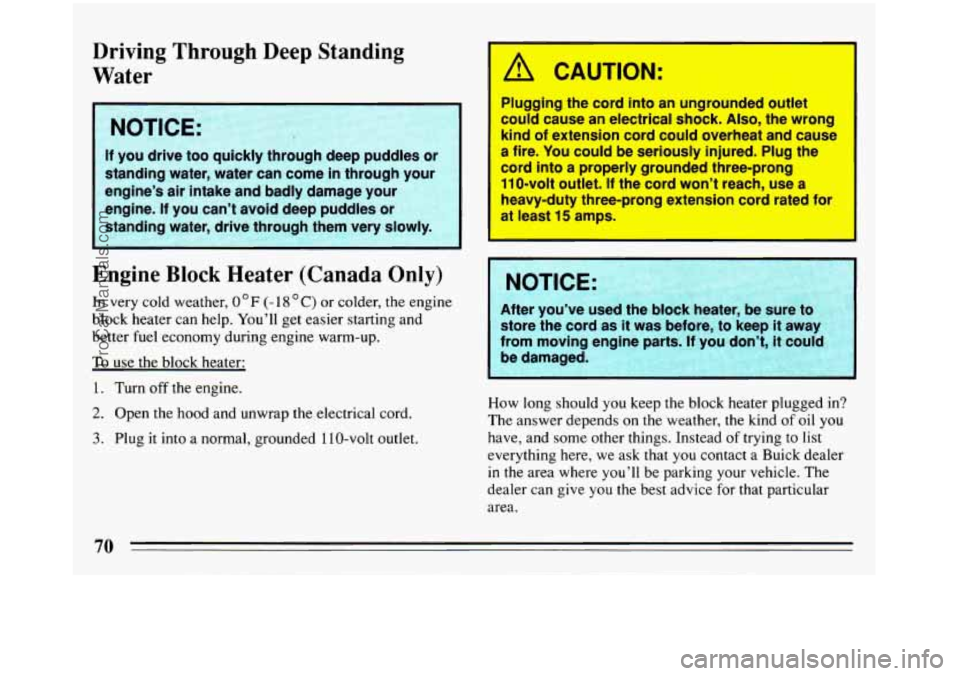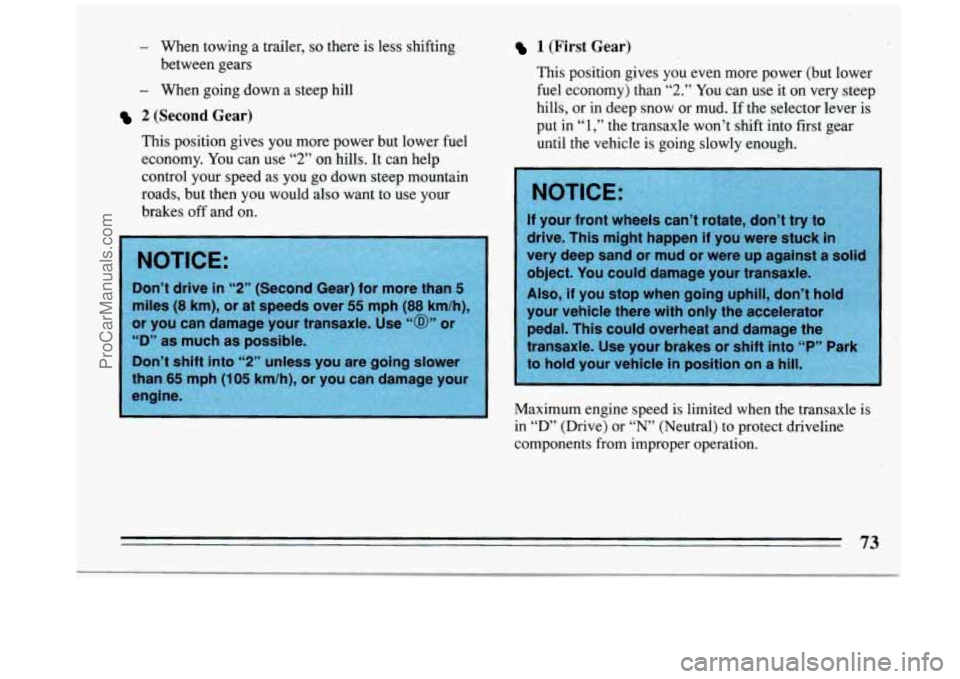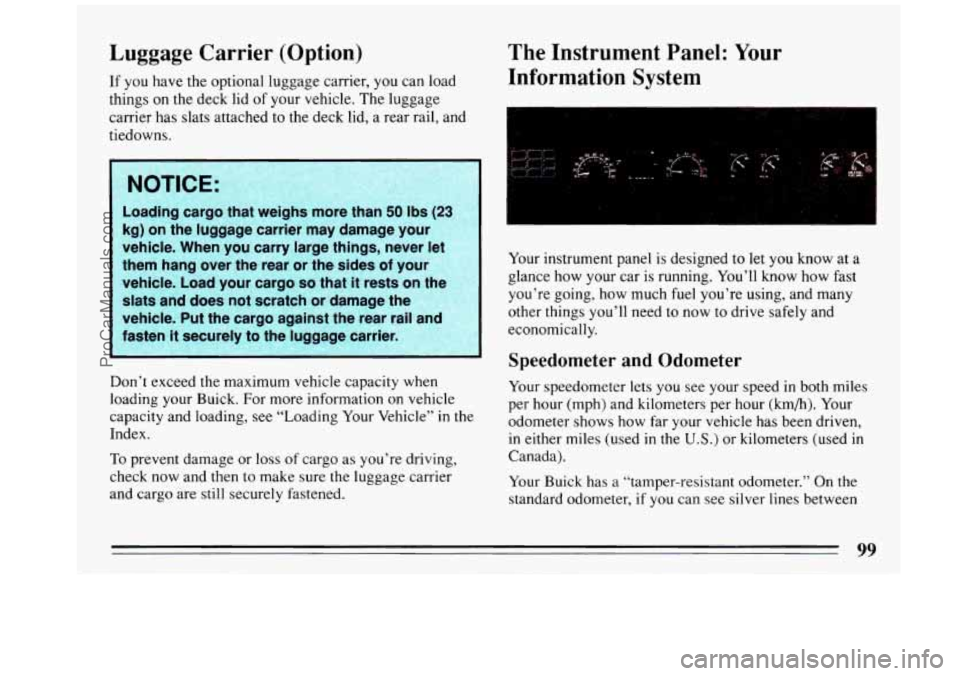1993 BUICK REGAL fuel
[x] Cancel search: fuelPage 14 of 308

Vehicle Symbols
These are some of the symbols you will find on your vehicle.
For example,
these symbols
are used on an
original battery:
POSSIBLE A
CAUTION
INJURY
PROTECT EYES BY
SHIELDING
CAUSTIC
BURNS AVOID
SPARKS
OR
FLAMES
SPARK
OR ,\I/,
COULD FLAME
EXPLODE BATTERY
These symbols
are important
for you and
your passengers
whenever your
vehicle
is
driven:
DOOR LOCK
UNLOCK
e
e
BELTS 4
POWER
WINDOW
These symbols
have
to do with
your lights:
SIGNALS e @
TURN
HIGH BEAM
OR = =o
FOG LAMPS $0
These symbols
are on some
of
your controls:
WINDSHIELD ' ' ' 0- 0-
WASHER
WINDSHIELD WASHER
WINDOW
DEFOGGER
VENTILATING FAN
HEADLAMP
-
WIPER
WASHER
Q
These symbols
are
used on
warning and
indicator lights:
COOLANT F-
TEMP --
ENGINE
CHARGING
I-1
BATTERY SYSTEM
BRAKE
(0)
RADIATOR 0
COOLANT
FUEL
ENGINE OIL w,
PRESSURE
TEMP
OIL &b
ANTILOCK (a)
BRAKE
Here are some
other symbols
you may see:
FUSE
RADIO
VOLUME
CONDITIONING
AIR 43
HATCHBACK TRUNK
RELEASE
t LIGHTER
HORN
SPEAKER
12
ProCarManuals.com
Page 70 of 308

To start your 3.1 Liter (Code T) engine:
1. Don’t push
the accelerator pedal before starting your
engine. In some other vehicles you might need to do
this, but because of your vehicle’s computer systems,
you don’t.
starts, let
go of the key. The idle speed will go down
as your engine gets warm.
2. Turn your ignition key to “Start.” When the engine
omng your Key In “Start” for longer tna
seconds at a time will cause your battery to
t
drained much sooner. And the excessive hear
3. If your engine won’t start (or starts but then stops), it
could be flooded with too much gasoline. Try
pushing your accelerator pedal all the
way to the
floor and holding it there
as you hold the key in
“Start” for about three seconds. If the vehicle starts
briefly but then stops again, do
the same thing, but
this time keep the pedal down for five
or six seconds.
This clears the extra gasoline from the engine.
[ electronics in your vehicle. If you add electrical
parts or accessories, you could change the way
the fuel injection system operates. Before adding
electrical equipment, check with your dealer.
1-
you don’t, your engine might not perforn
properly.
If you ever have to have your vehicle towed, see
the part
of this Manual that tells how to do it
without damaging your vehicle. See “Towing
Your Vehicle” in the Index.
4
-$,.-q*+&< ..,-. >%--:* ..“I)“:.. , .--..:<::.,: m.v;,,, ,‘‘Tmy, ““,u, .; ::x,.* ..,, L, W“ . , ~’‘&&‘, ’~=:.*>:** . .. l\l_ $p;Y-.T@ b
68
ProCarManuals.com
Page 71 of 308

To start your 3.8 Liter (Code L) engine:
1. Don’t push the accelerator pedal before starting your
engine. In some other vehicles you might need
to do
this, but because of your vehicle’s computer systems,
you don’t.
2. Turn your ignition key to “Start.” When the engine
starts,
let go of the key, The idle speed will go down
as your engine gets warm.
3. If it doesn’t start right away, hold your key in “Start”
for about three seconds at
a time until your engine
starts. Wait about
15 seconds between each try to
help avoid draining your battery.
Holding your key in “Start” for longer than 15
seconds at a time will cause your battery to be
drained much sooner.
And the excessive heat
can damage your starter motor.
4. If your engine still won’t start (or starts but then
stops), it could be flooded with too much gasoline.
Try pushing your accelerator pedal all the way to the
floor and holding
it there as you hold the key in
“Start” for about three seconds.
If the vehicle starts
briefly but then stops again,
do the same thing, but
this time keep the pedal down for five or six seconds.
This clears the extra gasoline from the engine. After
waiting about
15 seconds, repeat the normal starting
procedure.
electronics in your vehicle. If you add electric
parts or accessories, you could change
the way
the fuel injection system operates. Before adding
electrical equipment, check with your dealer
‘I.
you don’t, your engine might not perform
properly.
If you ever
h h hicle towea,
the part
of this Manual that tells how to do it
without damaging your vehicle. See “To
Your Vehicle” in the Index, :, ’ .
69
ProCarManuals.com
Page 72 of 308

Driving Through Deep Standing
Water
If you drive too quickly through deep puddles or
standing water, water can come in through your
engine’s
air intake and badly damage your
engine. If you can’t avoid deep puddles or
standing water, drive through them very slowly.
Engine Block Heater (Canada Only)
In very cold weather, 0 F (- 18 C) or colder, the engine
block heater can help. You’ll get easier starting and
better
fuel economy during engine warm-up.
To use the block heater:
1. Turn off the engine.
2. Open the hood and unwrap the electrical cord.
3. Plug it into a normal, grounded 110-volt outlet.
I
Plugging the cord into an ungrounded outlet
could cause an electrical shock.
Also, the wrong
kind of extension cord could overheat and cause
a fire. You could be seriously injured. Plug the
cord into
a properly grounded three-prong
IlO-volt outlet.
If the cord won’t reach, use a
heavy-duty three-prong extension cord rated for
at least
15 amps.
I
I
x; NOTICE:
k After you’ve used the block heater, be sure to
:; store the cord as it was before, to keep it away
i from moving engine parts. If you don’t, it could
:: be damaged. .’, :.,* :>”!;.:,.”~ i” < .:-;:.&,a2% && ?3$?%7 -
How long should you keep the block heater plugged in?
The answer depends
on the weather, the kind of oil you
have, and some other things. Instead
of trying to list
everything here, we ask that you contact a Buick dealer
in the area where you’ll be parking your vehicle. The
dealer can give
you the best advice for that particular
area.
70
ProCarManuals.com
Page 75 of 308

- When towing a trailer, so there.is less shifting
- When going down a steep hill between gears
’ 2 (Second Gear)
This position gives you more power but lower fuel
economy. You can use
2 on hills. It can help
control your speed as you go down steep mountain
roads, but then you would also want
to use your
brakes
off and on.
bb 97
miles (8 km), or at speeds over 55 mph (88 kmih),
or you can damage your transaxle. Use
‘@” or
“D” as much as possible.
Don’t shift into
“2” unless you are going slower
1 (First Gear)
This position gives you even,more power (but lower
fuel economy) than
“2.” You can use it on very steep
hills, or in deep snow
or mud. If the selector lever is
put’in
“1 ,” the transaxle won’t shift into first gear
until the vehicle
is going slowly enough.
Maximum engine speed
is limited when the transaxle is
in “D” (Drive) or
“N” (Neutral) to protect driveline
components from improper operation.
73
ProCarManuals.com
Page 101 of 308

Luggage Carrier (Option)
If you have the optional luggage carrier, you can load
things
on the deck lid of your vehicle. The luggage
carrier has slats attached to the deck lid, a rear rail, and
tiedowns.
NOTICE:
Loading cargo that weighs more than 50 Ibs (23
kg) on the luggage carrier may damage your
vehicle. When you carry large things, never let
them hang over the rear or the sides
of your
vehicle. Load your cargo
so that it rests on the
slats and does not scratch
or damage the
vehicle. Put the cargo against the rear rail and
fasten
it securely to the luggage carrier.
\ia , -~~”,~,,””,,~,~~.~,~~--.~~~,,~, L ,,*., ’L <““
The Instrument Panel: Your
Information System
Don’t exceed the maximum vehicle capacity when
loading your Buick. For more information on vehicle
capacity and loading, see “Loading Your Vehicle” in the
Index.
To prevent damage or loss of cargo as you’re driving,
check now and then to make sure the luggage carrier
and cargo are still securely fastened. Your
instrument panel is designed to let you know at
a
glance how your car is running. You’ll know how fast
you’re going, how much fuel you’re using, and many
other things you’ll need to now to drive safely and
economically.
Speedometer and Odometer
Your speedometer lets you see your speed in both miles
per hour (mph) and kilometers per hour (km/h). Your
odometer shows how far your vehicle has been driven,
in either miles (used
in the U.S.) or kilometers (used in
Canada).
Your Buick has
a “tamper-resistant odometer.” On the
standard odometer, if you can
see silver lines between
99
ProCarManuals.com
Page 103 of 308

When one of the warning lights comes on and stays on
when you are driving,
or when one of the gages shows
there may be a problem, check the section that tells
you
what to do about it. Please follow the manual’s advice.
Waiting to do repairs can be costly
-- and even
dangerous.
So please get to know your warning lights
and gages. They’re a big help.
Fuel Gage
UNLEADEL,
FUEL
ONLY
Your fuel gage shows about
how much
fuel is in your
tank. It works
only when
the engine is on. When the
indicator nears
“E,” you
still have a little fuel left.
You need to get more right
away.
Here are
four concerns some owners have had about the
fuel gage. All these situations are normal and indicate
nothing wrong with the
fuel gage.
8 At the gas station, the gas pump shuts off before the
gage reads
“F”.
indicated. For example, the gage indicated 1/2 full,
but
it took more -- or less -- than half of the tank’s
capacity
to fill it.
e It takes more (or less) gas to fill up than the gage
e The gage moves a little when you turn a corner,
speed
up, or stop your vehicle.
When
you turn the engine off, the gage doesn’t go all
the
way back to “E”.
Low Fuel Light
LOW
FUEL
When your fuel gage reads
in the red band, this light
will
go on. You should get
more fuel as soon
as you
can.
101
ProCarManuals.com
Page 109 of 308

Malfunction Indicator Lamp
(Service Engine Soon Light)
A computer monitors operation of your fuel, ignition
and emission control systems. This light should come
on
when the ignition is on, but the engine is not running, as
a check
to show you it is working. If it does not come on
at all, have it fixed right away.
If it stays on, or it comes
on while you are driving, the computer is indicating that
you have a problem. You should take your vehicle in for
service soon.
NOTICE:
If you keep drivln
after a while the em-ission controls won’t work as
well, your fuel economy won’t be
as good and
your engine may not run as smoothly. This could
I
lead to costly repairs not covered by yo
warranty. I
I
107
ProCarManuals.com